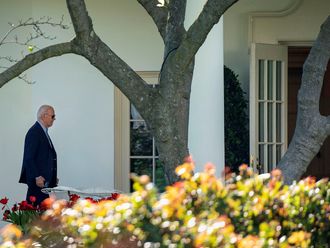San Francisco: Jihadists are in the cross-hairs of US social networks who are battling to enforce policies banning gruesome videos showing beheadings or hateful scenes such as flaunting hostages.
The Islamic State of Iraq and the Levant (Isil) group’s success at disseminating propaganda on social networks such as Twitter or YouTube has in turn given rise to online communities dedicated to vigilantly reporting posts that appear to violate rules laid out in terms-of-service.
“We review all reported content against our rules, which prohibit unlawful use and violent threats,” Twitter said in response to an AFP inquiry.
Twitter in August removed from its service photos and video of the beheading of US journalist James Foley that had been posted online by jihadists.
“We have been and are actively suspending accounts as we discover them related to this graphic imagery,” Twitter chief executive Dick Costolo posted at the time.
YouTube removes the videos from its site in accordance with its policy against “violent or gory content that’s primarily intended to be shocking, sensational or disrespectful”.
YouTube community guidelines available online include a “Don’t cross the line” category that told people “not to post bad stuff”.
“We encourage free speech and defend everyone’s right to express unpopular points of view,” the Google-owned global online video sharing platform said. “But we don’t permit hate speech.”
A video of British hostage John Cantlie was available on Thursday at YouTube, but returning to the link a day later resulted in the display of a message saying it had been removed due to content violating terms of service.
The video could still be found at other spots at YouTube, highlighting the fact that unwanted content can be reposted at different accounts with the service chasing after it as flags get raised.
Flag icons on YouTube pages allow viewers to report videos, offering a checklist of reasons including violent, repulsive, hateful or abusive content.
Reviewing reported videos is done all day, every day, with content related to extremist groups given high priority, according to YouTube.
The video-sharing service makes exceptions for violence in posts by news outlets, in much the same way that a television studio wouldn’t give an extremist organisation a channel but might have reporters deliver stories about shocking events.
YouTube also removes accounts registered to “foreign terrorist organisations” or which appear to be posting content on their behalf.
Social network Facebook flat-out bars extremist groups known for violent tactics from using the website, even if they promised to just post about harmless topics like favourite songs.
“We do not permit terrorist groups, such as ISIS [Isil], to use our site, and we do not allow any person or group to promote terrorism or share graphic content for sadistic purposes,” Facebook said Friday in response to an AFP inquiry.
“This has been our policy for more than five years, and something that we take very seriously.”
California-based Facebook has a team of employees armed with automated search tools scour the social network for accounts associated with “terror groups”.
Online social networks face the challenge of balancing free speech, worthy news events, and the desire not to be used as tools by extremist groups bent on violence and hate.
“These are tricky topics,” said Emma Llanso, director of the free expression project at the Center for Democracy and Technology in Washington, DC.
“I think all of the platforms have some room for improvement; it is not a perfect science.”
It is paramount for social networks to have policies in place and to make it clear to users what kinds of content will be booted from online venues, according to Llanso.
Social networks do seem to be keenly enforcing content rules in dealing with posts by Islamic State organization, which has earned a reputation for slickly wielding Internet tools to spread its message and recruit members.
“There may be a focused response around these videos, but calling it a crackdown would be going too far,” Llanso said.
Some intelligence analysts reason that it is smarter to allow extremist groups to essentially provide clues to their activities, admirers, and identities by posting on social networks.











